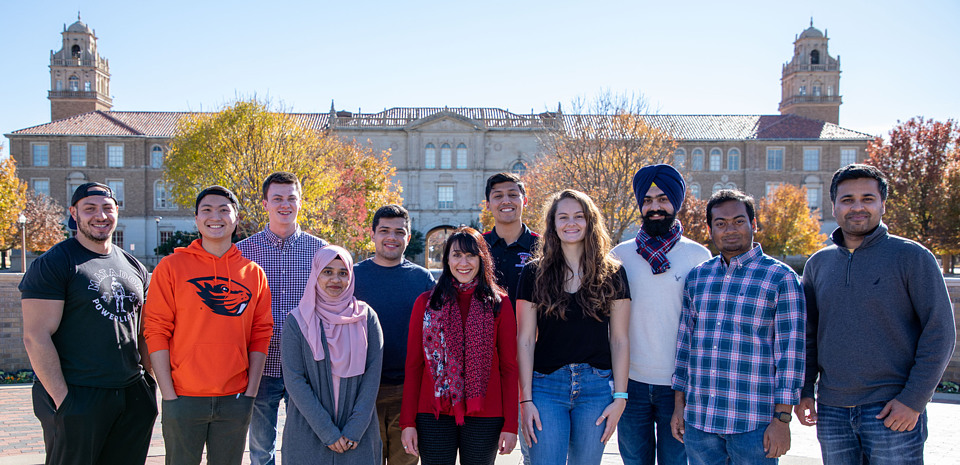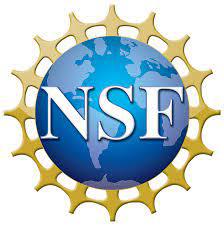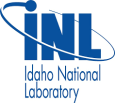Research
Our mission is to establish new concepts in heterogeneous catalysis that can enable the sustainable and renewable production of chemicals with precise atomic and molecular level detail. The broader impact of our work is to enable green technologies and circular economies and educate the engineering workforce of the future.
The Khatib Lab performs research, coupled with undergraduate and graduate level education, focusing on diverse aspects of heterogeneous catalysis. Our research includes nano and molecular catalyst synthesis, structural characterization, and kinetic testing, as well as catalytic reactor engineering, applied to chemically sustainable catalytic processes with industrial and energy applications. This includes the following topics:
- Natural gas conversion into useful chemicals.
- Dehydroaromatization reactions, production of cyclic organic compounds (benzene).
- Design of catalysts composed of oxides, metals, and carbides supported on porous supports.
- Production of COx-free hydrogen from methane.
- CO2 upgrading.
- Catalyst stability, strategies for regeneration, and deactivation pathways.
One of our current research topics focuses on the catalytic methane aromatization process, which is a sustainable reaction for the direct conversion of methane, from natural gas to benzene and hydrogen; we are developing novel zeolite-supported metal carbide catalysts with improved benzene selectivity and lower propensity to deactivation by carbon deposition. We are also investigating the evolution of supported mixed metal oxide catalysts, with the goal of understanding, at a molecular level, what structural changes are taking place in the active phases during the aromatization reaction. Our goal is to establish a correlation between the reaction pathways and their influence on the deactivation and regeneration pathways. To perform our studies, we are combining ex situ with in situ and operando characterization techniques, to obtain a more realistic picture of the structural and chemical changes that take place in the catalytic phases under dynamic reaction conditions.
Ongoing Funded Projects
Catalyst Design Strategies for Multifunctional Metal-Promoted Zeolites for Direct Valorization of Methane (funded by DOE-BES)
The vast availability of methane from shale, natural, bio-, heavy crude flue, and land fill gas in the past years has led to an increased interest in direct transformation routes to convert methane into value-added products in one step. Catalytic methane dehydroaromatization (MDA) [6 CH4 (g) --> C6H6 (g) + 9 H2 (g)] directly valorizes methane to aromatic building blocks such as benzene, light hydrocarbons, and a significant amount of hydrogen. One of the major drawbacks that prevents implementation of this process at an industrial level is the rapid catalyst deactivation by coking. This project investigates a promising strategy to mitigate the effect of coking by developing multifunctional catalysts consisting in Mo/ZSM-5 promoted with small amounts of a second metal X (X = Fe, Co, or Ni), which seem to modulate both the amount and the nature of the carbon deposits formed in reaction. We are designing specific multifunctional catalysts containing both Mo and X metals to produce catalyst structures that enable rigorous structure-activity elucidations. We employ a suite of ex situ structural characterization techniques, advanced in situ/operando X-ray absorption techniques (XAS), along with steady state and transient kinetic (temperature programmed surface reaction and CH4-pulsing) experiments to achieve fundamental understanding of the structural evolution of the active metal sites during the entire catalyst life cycle (activation-reaction-deactivation-regeneration). In this way we aim to provide fundamental insights at a molecular level on the Mo-X surface interactions and their capacity to steer the reaction and deactivation pathways in MDA.
Designing a Methane Dehydroaromatization (MDA) Process for Feedstock Flexibility and High-On-Stream Time via Dynamic Kinetic and Thermodynamic Control (funded by DOE-EERE-AMO)
The methane dehydroaromatization process counts on two drawbacks: (1) thermodynamic limitation in methane equilibrium conversion, and (2) rapid deactivation of zeolite-supported Mo catalysts. In this project our objective is to overcome these limitations by designing an alternative conversion technology that engineers the delivery of oxidant co-reactants into the reactor system using a gradient feed membrane reactor (GFMR). This approach will improve the process thermodynamics and increase methane conversion while maintaining a high benzene selectivity and preventing oxidative destruction of the active sites. For the process to meet DOE technical targets, we propose an integrated approach that combines (1) the design of a GFMR for oxidative MDA; (2) the design of stable catalysts ; (3) evaluation of the dynamic range of microkinetic properties of the catalysts in the GFMR conditions; (4) determination of structure-activity relationships in a GFMR by in situ/operando experiments; (5) process simulations and techno-economic analyses at demonstration and production scales. This work will result in a new, cost-effective process for producing aromatics using known carbon emitting waste streams. This project is a close collaboration between researchers at Texas Tech University (Khatib and Chen groups in the Department of Chemical Engineering), Idaho National Laboratory (Fushimi group), the Shepherd Chemical Company (Hart), and the Stanford Synchrotron Radiation Lightsource at SLAC National Laboratory (Bare).
CAREER: Tailoring the Synergy between Catalyst Design and Reaction Engineering for Direct Conversion of Methane to Aromatics (funded by NSF)
Mo oxide supported on HZSM-5 is the most commonly studied catalyst for the methane dehydroaromatization reaction. It is agreed that during an induction period Mo oxide species transform to Mo carbide species that are responsible for the conversion of CH4 to aromatics. Adding oxidant co-reactants can help the process thermodynamics, however, only low oxidant concentrations can be used since the active Mo carbide phases will otherwise be oxidatively destroyed. At low oxidant concentrations benzene yields are improved but the oxidant distribution in a packed-bed reactor is not even, thus kinetic measurements are not representative of the entire catalyst bed. Using distributed-feed membrane reactors (DFMR) can overcome the reactor heterogeneity and increase benzene yields two-fold, but catalyst coking is not fully prevented. Our group has found that catalyst’s resistance to coking can be enhanced by preparing Mo carbide phases ex situ in presence of a 2nd metal X (X= Fe, Co, or Ni). The nature of the Mo-X interaction remains unknown. In this prroject we study these stable Mo-X/HZSM-5 catalysts while they operate in a DFMR with O2 or CO2 co-reactants. The goal of this project is to determine the role that Mo-X-C interactions play on the reaction and deactivation pathways within a DFMR fed with an oxidant. We monitor the structure, location, and evolution of the Mo-X phases by in situ and Operando experiments using advanced characterization techniques, including X-ray absorption and high-resolution powder diffraction. The combination of the kinetic tests and in situ structural characterization, will give us insight on the reaction and deactivation pathways of methane dehydroaromatization in presence of oxidants and will provide the basis for the rational design of catalysts tailored for use in a DFMR environment.
Integrated Experimental and Theoretical Endeavor for Fundamental Understanding of Processes in Methane Dehydroaromatization (funded by NSF) (PI Khatib, co-PI Howe)
Our previous work has revealed that the specific processes by which a ZSM-5-supportted Mo oxide precursor is activated to form Mo carbide species strongly affects the catalytic behavior. Thus, Mo-C-support interactions play a pivotal role in achieving the stable formation of aromatics. To further investigate those interactions, we are preparing and evaluating model catalysts, with active metals existing only on either the outer surface or within the zeolite channels, using a suite of experimental and computational tools. The structure, location, and evolution of the Mo species is monitored by in situ and operando experiments using advanced characterization techniques, including X-ray absorption and high-resolution powder diffraction. The experimental data are combined with density functional theory calculations to advance knowledge with respect to the structure-activity relationship of the catalysts and the reaction pathways involved in the complete methane dehydroaromatization catalytic cycle (activation, reaction, deactivation, regeneration). The combination of kinetic tests, in situ structural characterization, and theoretical calculations will result in the determination of the reaction and deactivation pathways of MDA and will provide the basis for the rational design of catalysts. Beyond the research efforts, we are also developing a novel virtual reality (VR) technology module that will allow K-12 students to immerse themselves into a catalyst structure and allow them to directly interact with dynamic 3-D images of the molecules involved in a catalytic process.
Funding
Collaborators
SLAC National Laboratory
Stanford Synchrotron Radiation Lightsource
Co-ACCESS Group
Simon Bare
Adam Hoffman
Idaho National Laboratory
Rebecca Fushimi
Yixiao Wang
Brookhaven National Laboratory
Chemistry Department, CRS Group
Sanjaya Senanayake
Jose Rodriguez
National Synchrotron Light Source II
ISS: Eli Stavitski
CSX-2: Adrian Hunt and Iradwikanari Waluyo
Center for Functional Nanomaterials
TEM/STEM: Andrew Gamalski
Texas Tech University
Department of Chemical Engineering
Josh Howe
Chau-Chyun Chen
Department of Civil, Environmental, and Construction Engineering
Yuexiao Shen
Jennifer Guelfo
Department of Chemistry
Dominick Casadonte
Anthony Cozzolino
University of Málaga (Spain)
Department of Inorganic Chemistry
Antonia Infantes-Molina











